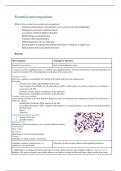Samenvatting
Summary List of essential microorganisms mechanisms of disease 1
- Instelling
- Universiteit Leiden (UL)
Een volledig uitgewerkte lijst van alle essentiële micro-organismen die besproken worden in het vak mechanisms of disease 1.
[Meer zien]








